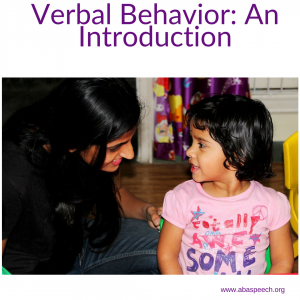The Importance of Verbal Behavior
In Applied Behavior Analysis, verbal behavior is an important component in what we do everyday. It helps us understand and teach people how to interact with other people, whether it’s asking a server to get you water, or engaging in complex discussions, like debates. It describes the system behind how we interact with other people to get our needs met. That’s super important. Why is that so? Well, before I can answer that, let me start with explaining what verbal behavior is.
What is it?
According to Cooper, Heron, and Heward (the authors of Applied Behavior Analysis, aka the Bible equivalent to all BCBAs) they define verbal behavior as “behavior whose reinforcement is mediated by a listener.” What does that mean? Well, think of it this way: anything that a person does that is reinforced by another person is verbal behavior. For instance, if a child points to their bottle of water and I walk over to the water, grab it, and give it to that child, that is verbal behavior. The same is true if the child were to say “water.” Both behaviors were rewarded by a person which will increase a child’s requests in the future. Got it? Let’s keep moving ahead then!
Basic Types of Communication
In the example above, the child evoked verbal behavior in the form of a request (aka MAND). While this probably is the most common type of verbal behavior, there are others as well, such as Tacts, Echoics, Intraverbals. Check out the graph below to learn more about what each is about!
So, why should you care about this?
Bottom line: verbal behavior is communication, and all the basic types of verbal behaviors are imperative to navigate the complex social world we live in. That’s massive! Imagine you didn’t have the ability to ask questions (Intraverbals). Try going 2 minutes in a conversation without asking a question. You can’t. Questions are so important. So are labels (TACTS). Have you ever tried counting how many times we label something that we think is interesting/cool/useful? It’s way, way more than you think. That’s why we consider verbal behavior so important. It’s meshed into every single part of our lives. That’s why we make a big deal out of it and why all ABA programs include communication goals. From teaching a child to point to things they want to engaging in back and forth conversations with other peers, verbal behavior is embedded so that we can help learners develop these critical skills.
About Cultivate: Cultivate Behavioral Health & Education provides ABA therapy in Central Texas, serving children with autism and other developmental disabilities. We serve children starting in their early intervention programs, through their high school years. Through Applied Behavior Analysis, our organization provides the highest-quality behavior modification services available in the greater Austin, San Antonio, & Houston areas. LEARN MORE


0 Comments